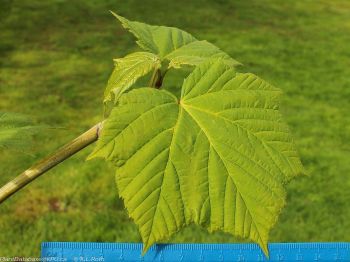Scientific Name:
Acer tegmentosum
Pronunciation:
AY-sur teg-men-TOE-zum
Common Name:
Manchurian snakebark maple, Manchu striped maple
Family Name:
Sapindaceae
Plant Type:
Tree - deciduous
Key ID Features:
Branches pale green at first becoming striped chalk-white; leaves opposite, orbicular, 12-16cm wide, most with 3-5 shallow lobes and double serrate margins; flowers small, in nodding racemes 7-10cm long, greenish-yellow; schizocarp 2-3cm wide, wings at 110-160 degree angle, samaras 1-1.5 cm long. Winter ID: vase shaped; buds opposite, two dark red scales, pointy; bark green striped. Winter ID: bark greenish-gray with white vertical stripes, buds smooth, dark red, valvate, stalked, 7-10mm long, may curve towards twig, terminal bud 12-15mm long.
Habit:
Open, Spreading
Form:
Oval - horizontal
Texture:
Medium - coarse
Mature Height:
7 - 10m
Mature Spread:
7 - 10m
Growth Rate:
Moderate
Origin:
Garden origin (E. Russia, Manchuria, Korea)
Hardiness Rating:
Zone 5: (-29 to -23 °C)
Exposure:
Full sun, Part sun/part shade, Filtered shade
Soil/Growing Medium:
Well-drained
Landscape Uses:
Accent plant, Fall interest, Shade tree, Specimen plant, Spring interest, Summer interest
Additional Info:
Google. Cultivars shown may include A. 'Joe Witt'. Compare to A. pensylvanicum and A. davidii (also called striped or snakebark maple).
Leaf Morphology:
Form:
Simple, Lobed
Arrangement:
Opposite
Texture/Venation:
Soft flexible, Palmate venation
Surfaces:
Glabrous
Colour in Fall:
Yellow
Shapes:
Obovate, Orbicular
Apices:
Acuminate
Bases:
Cordate
Margins:
Double serrate
Additional Info:
Spectacular fall colour, 3-5 shallow lobes
Bark Morphology:
Showy, Lightly fissured
Bark or Stem Colour:
White, Grey, Green
Additional Info:
Vertical fissures
Leaf Bud Type:
Narrowly conical, Valvate
Leaf Scar Shape:
Crescent shaped
Organ Modifications:
Fibrous-like roots
Propagation:
Seed
Maintenance:
Low
Pest Susceptibility:
Anthracnose, Canker or sap rot, Fungal leaf spot (Pest resistant, Disease resistant, Deer resistant)





